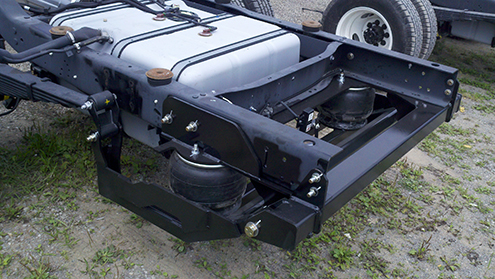

Kelderman air suspensions lend a smoother ride
By Lanny Lammers
Ron Biss, an advocate for accessible transportation, is a member of the Minnesota DOT and the Twin Cities MPO advisory committees, which advise on management policies in various areas of public transportation. Biss, a wheelchair user himself, says one frequent complaint he hears is the rough ride passengers experience on small paratransit buses.
“This is a major issue and concern to many of the people who ride paratransit,” he says, “It can be particularly rough on passengers with pain issues including injuries or disease. Riders suffering from pressure sores suffer even worse on a rough bus ride.”
He says some riders are simply not capable of repositioning themselves when bumps and vibrations jar them out of a comfortable position.
Biss recently took a test ride down a very rough street on a new paratransit bus equipped with the Kelderman air suspension system.
“I realized I was subconsciously prepared to tolerate an uncomfortable, tortuous ride,” he says. “It didn’t happen. Instead, I felt no jarring and very little vibration. I am convinced the community of paratransit riders would really welcome a Kelderman add-on air suspension system.”
With 25 years in suspension innovation, Kelderman air suspension systems have become the preferred choice of ambulance manufacturers nationwide.
Realizing the need for a better ride on smaller paratransit and shuttle vehicles, the company has developed a cost-effective solution to reduce the shock and vibration to the bus body. Kelderman says its systems can lower maintenance expenses and prolong the life of the bus, and can be equipped for around $3,000.
Comfort, stability and maintenance

The two-stage suspension attaches to the back of the rear leaf springs, allowing the rear springs to stay in place and maintain the stability they provide. This is not an independent suspension. The driver side and passengers’ side frame rails act as one, due to a series of cross members connecting the two sides. This feature helps maintain roll resistance and stable handling during high-speed turns. Both frame rails remain level with one another, even with the added weight of a wheelchair lift.
Kelderman’s two-stage suspension should not be confused with an air bag added between the axle and the frame. These types of systems merely help the springs carry additional weight and actually degrade the quality of the ride. The two-stage system has only two wear points. Kelderman says suspensions that completely replace the springs have several more wear points, making them more expensive to maintain.
The Kelderman air suspension kit comes with a sealed compressor/dryer, sensor and a relay, which the company says has fewer components than competing air kits and costs less to maintain.
“This simple and common sense engineering is what transportation providers have been looking for,” says Biss.“It is an effective way to improve the ride without spending a lot of money for the suspension, as well as the repairs.” BR
_________________________________________________________________
Lanny Lammers serves as OEM sales manager, Kelderman Air Suspension, Inc., Oskaloosa, IA.
